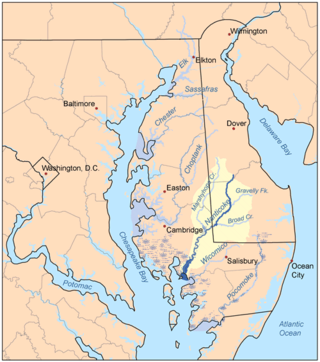Related Research Articles

The Delmarva Peninsula, or simply Delmarva, is a large peninsula and proposed state on the East Coast of the United States, occupied by the vast majority of the state of Delaware and parts of the Eastern Shore of Maryland and Eastern Shore of Virginia.

Somerset County is the southernmost county in the U.S. state of Maryland. As of the 2020 census, the population was 24,620, making it the second-least populous county in Maryland. The county seat is Princess Anne.

The Lenape, also called the Lenni Lenape and Delaware people, are an Indigenous people of the Northeastern Woodlands, who live in the United States and Canada.

The Nanticoke people are a Native American Algonquian people, whose traditional homelands are in Chesapeake Bay and Delaware. Today they live in the Northeastern United States and Canada, especially Delaware; in Ontario; and in Oklahoma.
Turkey Tayac, legally Philip Sheridan Proctor (1895–1978), was a Piscataway leader and herbal medicine practitioner; he was notable in Native American activism for tribal and cultural revival in the 20th century. He had some knowledge of the Piscataway language and was consulted by the Algonquian linguist, Ives Goddard, as well as Julian Granberry.

The Piscataway Indian Nation, also called Piscatawa, is a state-recognized tribe in Maryland that is descended from the historic Piscataway people. At the time of European encounter, the Piscataway was one of the most populous and powerful Native polities of the Chesapeake Bay region, with a territory on the north side of the Potomac River. By the early seventeenth century, the Piscataway had come to exercise hegemony over other Algonquian-speaking Native American groups on the north bank of the river. The Piscataway nation declined dramatically before the nineteenth century, under the influence of colonization, infectious disease, and intertribal and colonial warfare.

The Piscataway or Piscatawa, are Native Americans. They spoke Algonquian Piscataway, a dialect of Nanticoke. One of their neighboring tribes, with whom they merged after a massive decline of population following two centuries of interactions with European settlers, called them the Conoy.
The Nanticoke Lenni-Lenape Tribal Nation are a tribal confederation of Nanticoke of the Delmarva Peninsula and the Lenape of southern New Jersey and northern Delaware. They are recognized by the state of New Jersey, having reorganized and maintained elected governments since the 1970s. They are not a federally recognized tribe.

The Doeg were a Native American people who lived in Virginia. They spoke an Algonquian language and may have been a branch of the Nanticoke tribe, historically based on the Eastern Shore of Maryland. The Nanticoke considered the Algonquian Lenape as "grandfathers". The Doeg are known for a raid in July 1675 that contributed to colonists' uprising in Bacon's Rebellion.
Nanticoke is an Algonquian language formerly spoken in Delaware and Maryland, United States. The same language was spoken by several neighboring tribes, including the Nanticoke, which constituted the paramount chiefdom; the Choptank, the Assateague, and probably also the Piscataway and the Doeg.
The Pocomoke people were a historic Native American tribe whose territory encompassed the rivers Pocomoke, Great Annemessex, Little Annemessex, and Manokin, the bays of Monie and Chincoteague, and the sounds of Pocomoke and Tangier.
The Assateague were an Algonquian people speaking the Nanticoke language who historically lived on the Atlantic coast side of the Delmarva Peninsula.
The Accomac people were a historic Native American tribe in Accomack and Northampton counties in Virginia. They were loosely affiliated with the Powhatan Confederacy.
The Matapeake were an Indigenous Algonquian people who lived on Kent Island, which they referred to as Monoponson in their language. The Matapeake, along with the Choptank, Lenape, and Nanticoke, were the four most prominent Algonquian tribes living in Maryland.
The Ozinie, also known as the Wicomiss, were a group of Native Americans living near modern-day Rock Hall, in Kent County, Maryland. They were hunter-gatherers and fished.

The Indigenous peoples of Maryland are the tribes who historically and currently live in the land that is now the State of Maryland in the United States of America. These tribes belong to the Northeastern Woodlands, a cultural region.
Askiminokonson, called Indian Town by English settlers, was a Native American settlement in Maryland. It was inhabited by the Pocomoke, Annamessex, Manokin, Nasswattex, and Acquintica Native American tribes. It was the largest Native American settlement in Maryland in 1671, and was incorporated into another reservation in 1686. Askiminokoson was located just north of the Pocomoke River, near present-day Snow Hill, Maryland. Askiminokoson was mentioned in the proceedings of the Council of Maryland in 1686 as part of a land dispute between settlers and Native Americans.
References
- Feest, Christian F. (1978). Trigger, Bruce G. (ed.). Handbook of North American Indians: Northeast, Vol. 15. Washington, DC: Smithsonian Institution. pp. 240–48.